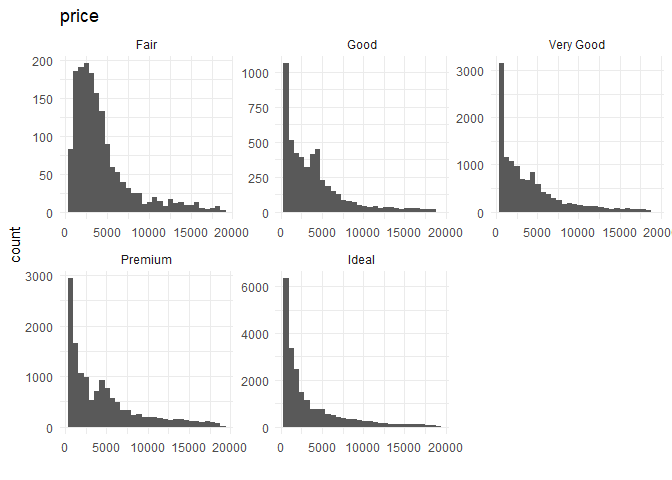I am trying to write a wrapper function using ggplot2 and rlang (tidy eval). Below is paired down example of what I am trying to do. The function will work as expected for some arguments to facet_wrap but not for others.
We see below that the facetting works correctly when argument equals NULL or when the facet variable is cut. When I try to use other variables in the same data set, then I get a mystery error that I cannot figure out.
I'm hoping that there is something simple that I am missing and someone can shed some light.
Thanks!
gg_histo <- function(data,
var,
facet = NULL,
theme_for_histo = theme_minimal(),
title = NULL,
subtitle = NULL) {
#### quo some vars brah --------------------------------
var_enq <- rlang::enquo(var)
var_name <- rlang::quo_name(var_enq)
facet_enq <- rlang::enquo(facet)
#### Make the main plot --------------------------------
res <- ggplot(data = data,
aes(x = !! var_enq)) +
geom_histogram(stat = "bin") +
labs(title = var_name,
x = "",
subtitle = subtitle) +
theme_for_histo
#### Facet if applicable --------------------------------
if (!is.null(facet)) {
res <- res +
facet_wrap(vars(!! facet_enq),
scales = "free")
}
#### Return the plot --------------------------------
return(res)
}
#### Some examples --------------------------------
library(tidyverse)
dplyr::glimpse(diamonds)
#> Observations: 53,940
#> Variables: 10
#> $ carat <dbl> 0.23, 0.21, 0.23, 0.29, 0.31, 0.24, 0.24, 0.26, 0.22, ...
#> $ cut <ord> Ideal, Premium, Good, Premium, Good, Very Good, Very G...
#> $ color <ord> E, E, E, I, J, J, I, H, E, H, J, J, F, J, E, E, I, J, ...
#> $ clarity <ord> SI2, SI1, VS1, VS2, SI2, VVS2, VVS1, SI1, VS2, VS1, SI...
#> $ depth <dbl> 61.5, 59.8, 56.9, 62.4, 63.3, 62.8, 62.3, 61.9, 65.1, ...
#> $ table <dbl> 55, 61, 65, 58, 58, 57, 57, 55, 61, 61, 55, 56, 61, 54...
#> $ price <int> 326, 326, 327, 334, 335, 336, 336, 337, 337, 338, 339,...
#> $ x <dbl> 3.95, 3.89, 4.05, 4.20, 4.34, 3.94, 3.95, 4.07, 3.87, ...
#> $ y <dbl> 3.98, 3.84, 4.07, 4.23, 4.35, 3.96, 3.98, 4.11, 3.78, ...
#> $ z <dbl> 2.43, 2.31, 2.31, 2.63, 2.75, 2.48, 2.47, 2.53, 2.49, ...
gg_histo(data = diamonds,
var = price,
facet = NULL)
#> `stat_bin()` using `bins = 30`. Pick better value with `binwidth`.

gg_histo(data = diamonds,
var = price,
facet = cut)
#> `stat_bin()` using `bins = 30`. Pick better value with `binwidth`.

gg_histo(data = diamonds,
var = price,
facet = color)
#> Error in gg_histo(data = diamonds, var = price, facet = color): object 'color' not found
gg_histo(data = diamonds,
var = price,
facet = clarity)
#> Error in gg_histo(data = diamonds, var = price, facet = clarity): object 'clarity' not found
Created on 2018-09-24 by the reprex package (v0.2.1)

 I think I figured this one out: it's because
I think I figured this one out: it's because 
